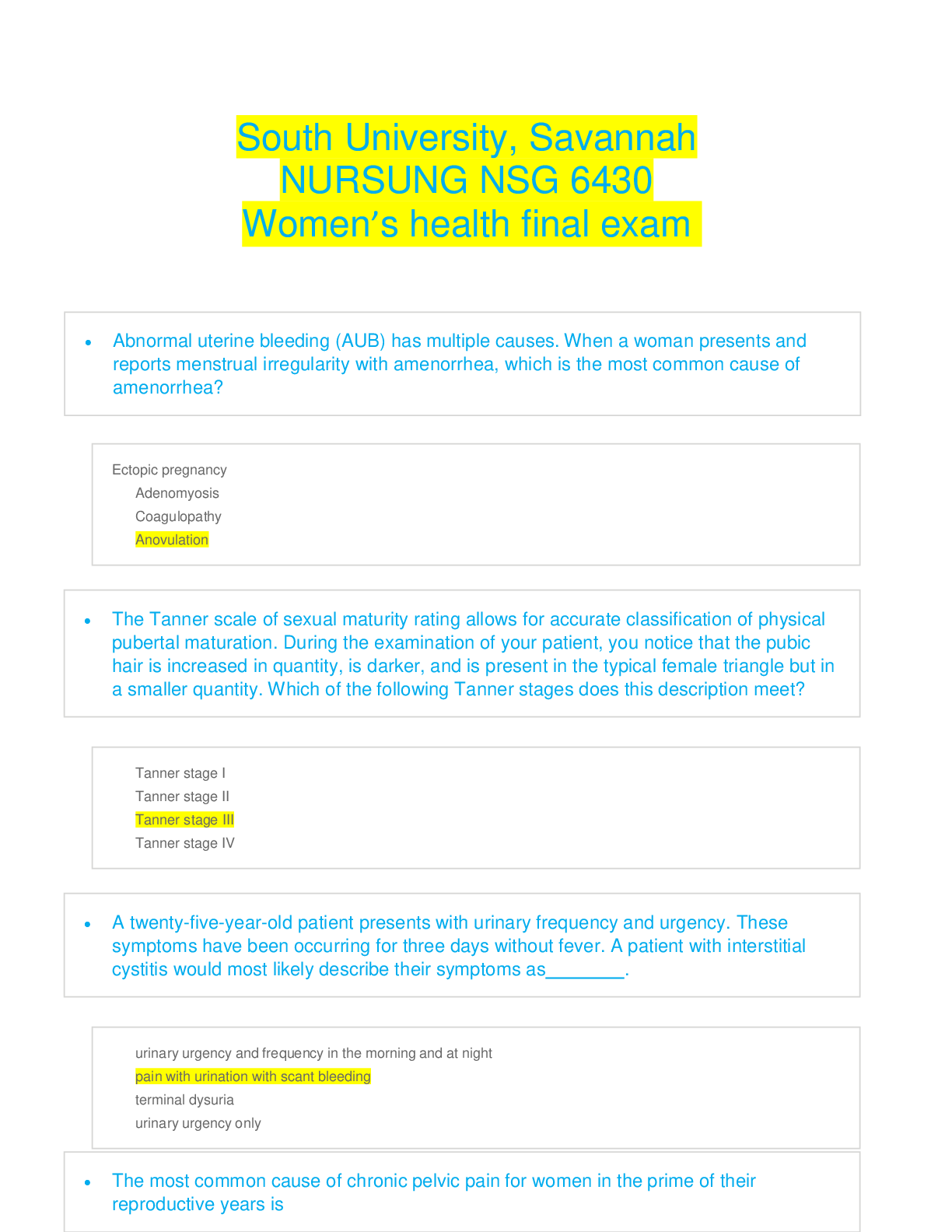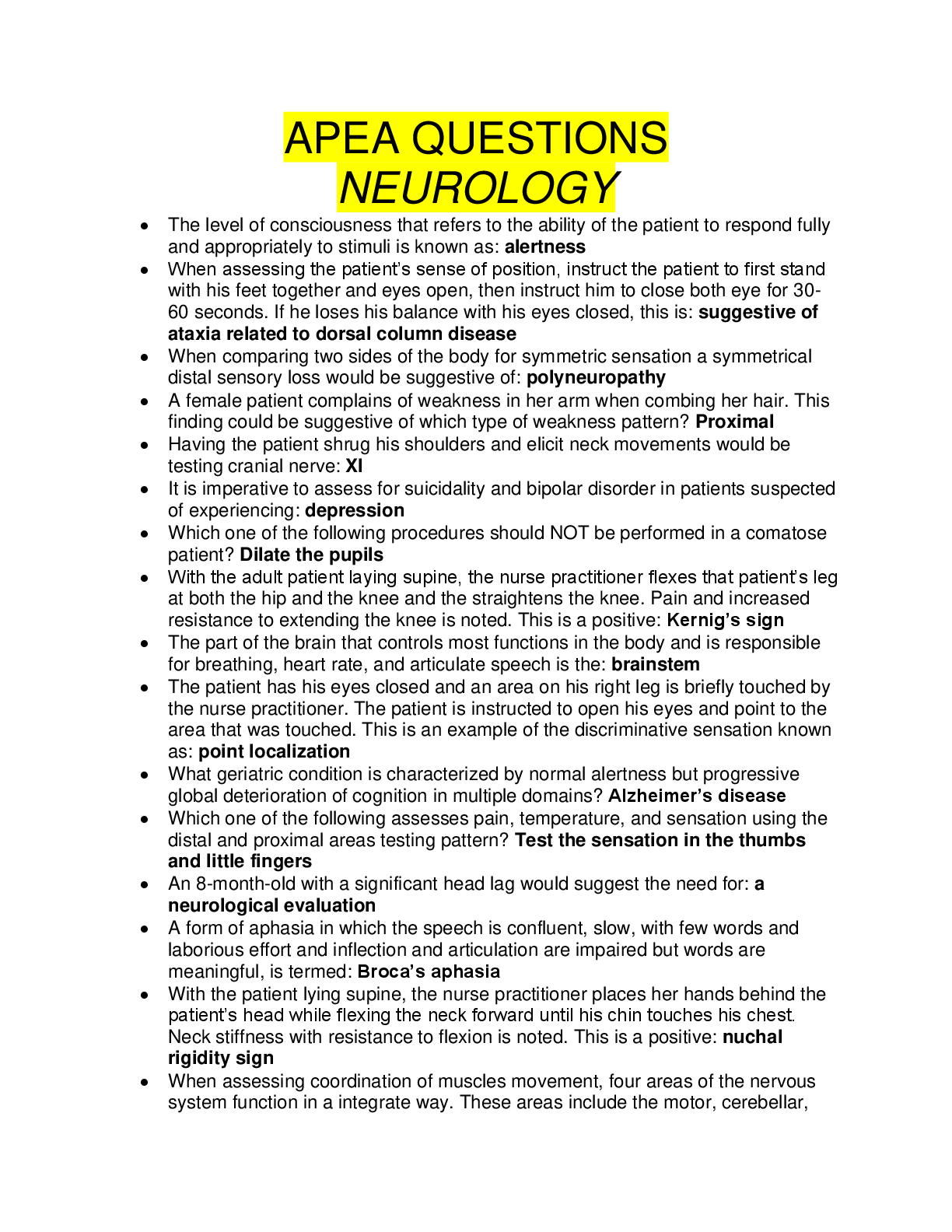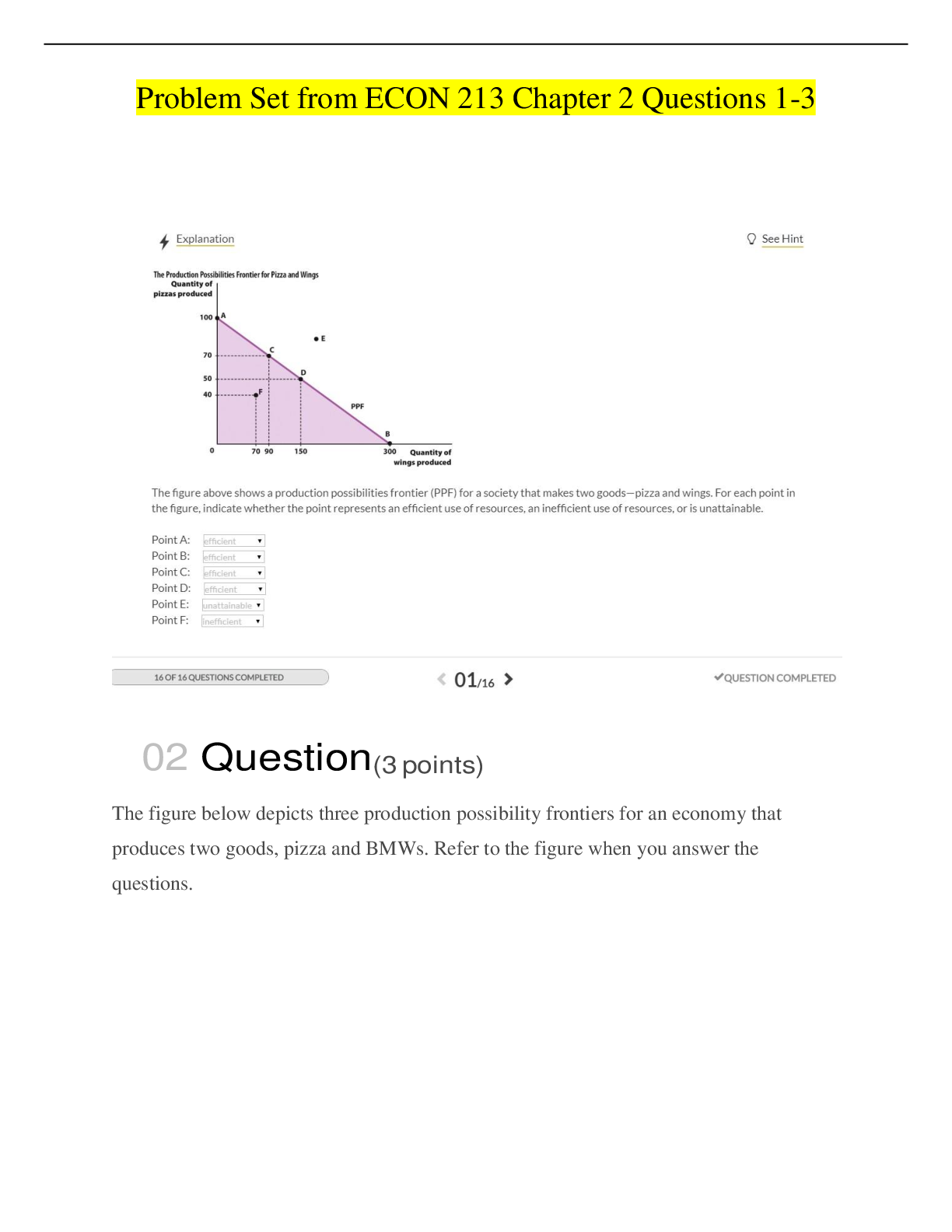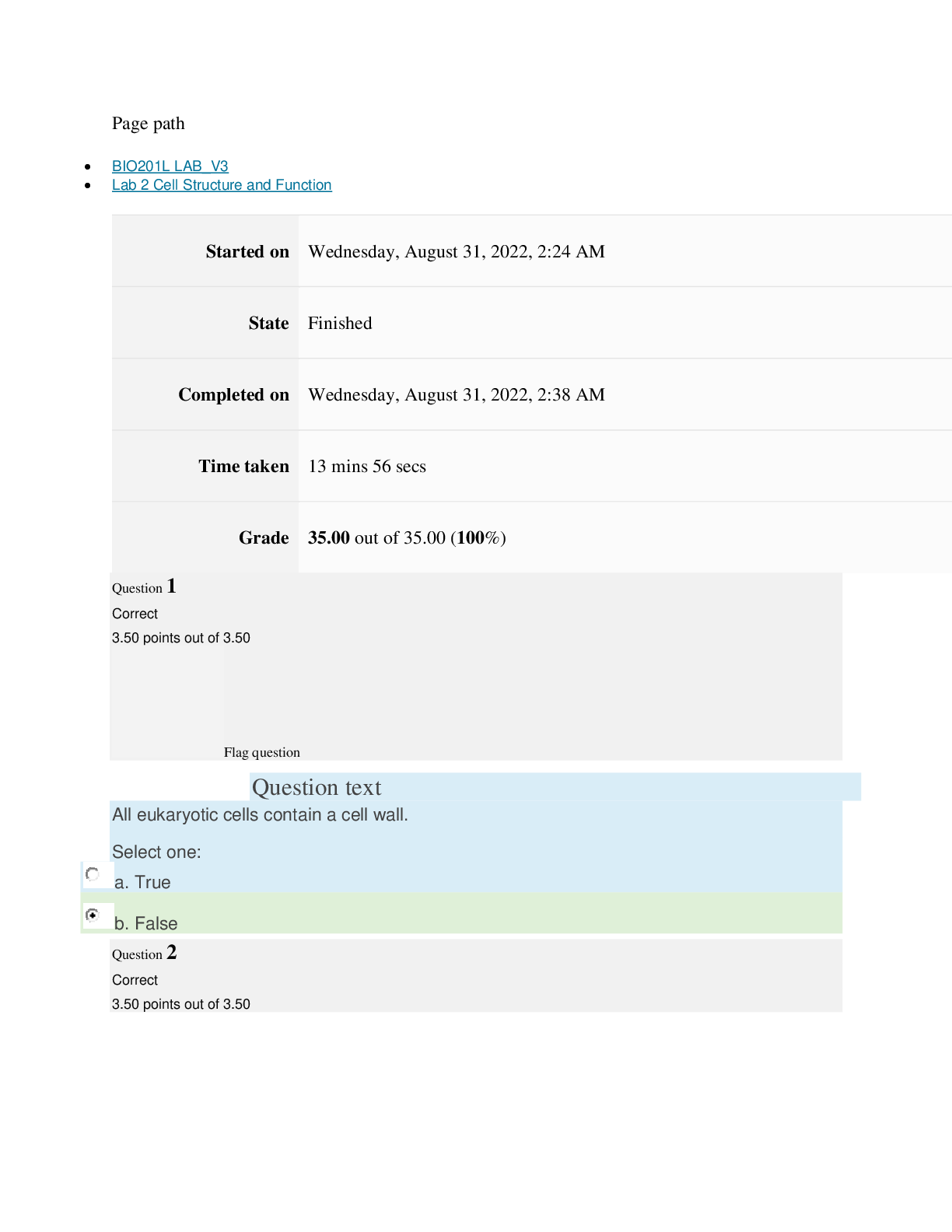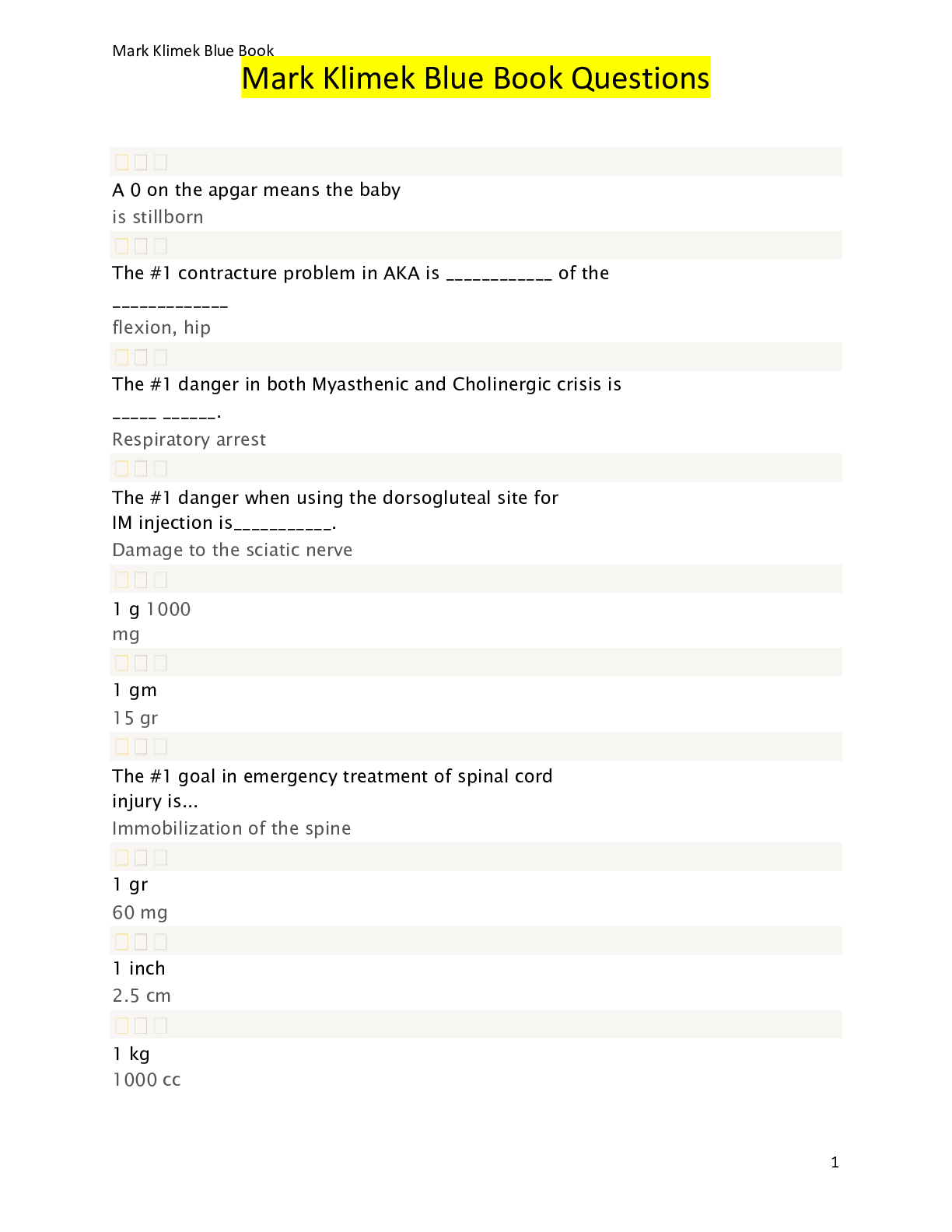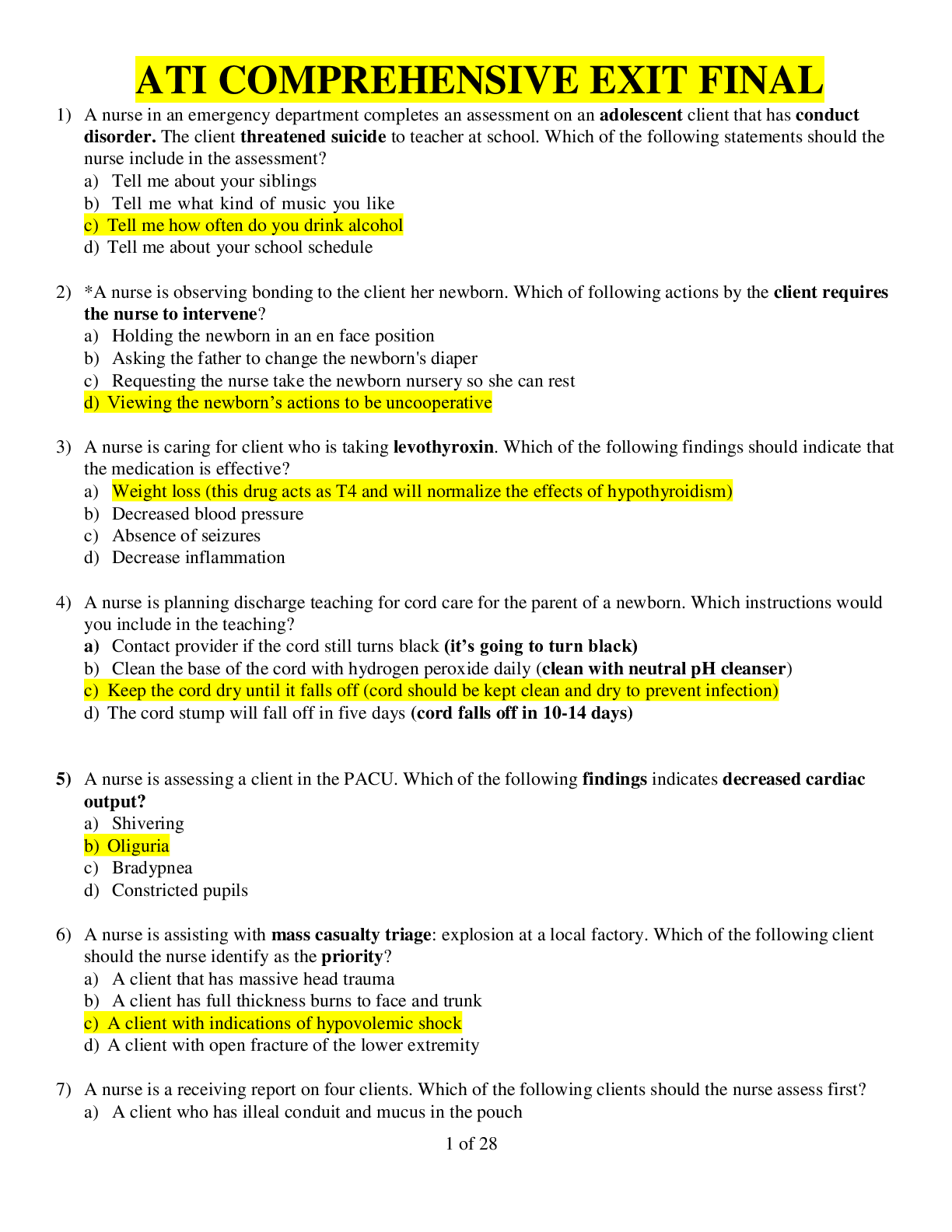*NURSING > QUESTIONS & ANSWERS > MARYWOOD UNIVERSITY, NURSING 351, NCLEX QUESTION (ALREADY GRADED A) (All)
MARYWOOD UNIVERSITY, NURSING 351, NCLEX QUESTION (ALREADY GRADED A)
Document Content and Description Below
NCLEX Questions The nurse is caring for a patient who is diagnosed with AIDS and was prescribed nevirapine (an NNRTI) two weeks ago. While assessing the patient, the nurse should be alert for: Selec... t all that apply. Choose Your Favorite Jaundice. Raised pinkish-brown nonpruritic patches on the skin or mucous membranes. White patches in the mouth. Dry cough. Low Urine Specific Gravity The nurse is reviewing the complete blood count (CBC) of a healthy patient. Which of the following white blood cells should the nurse expect to be most numerous? Choose Your Favorite Basophils Eosinophils Lymphocytes Neutrophils A patient is seen in the emergency department after a bee sting caused bronchospasms and severe pruritis. The nurse understands that this type of hypersensitivity reaction is: Choose Your Favorite Type I. Type IV. Type III. Type II. • A type III immune complex hypersensitivity reaction involves antigen-antibody complexes that are not adequately cleared, leading to an inflammatory response. The reaction may take 3 - 10 hours after exposure to the antigen. It is mediated by soluble immune complexes and complement (C3a, 4a and 5a). They are mostly of the IgG class, although IgM may also be involved. The damage is caused by platelets and neutrophils. Neutrophils and deposits of immune complexes and complement are seen. Examples include lupus, aspergillosis, polyarteritis, and post-streptococcal glomerulonephritis. • A type IV cell-mediated hypersensitivity, also called a delayed hypersensitivity reaction, involves sensitized T-cells and takes several days to develop. The classical example of this hypersensitivity is tuberculin (Montoux) reaction, which peaks 48 hours after the injection of antigen (PPD or old tuberculin). The lesion is characterized by induration and erythema. Type IV hypersensitivity is involved in the pathogenesis of many autoimmune and infectious diseases (tuberculosis, leprosy, histoplasmosis, toxoplasmosis) and granulomas, due to infections and foreign antigens. Another example is contact dermatitis (poison ivy). The nurse is reviewing the results of genetic testing of a patient with sickle cell disease, noting that HbS indicates sickle cell disease, HBAS indicates sickle cell trait and HbA indicates normal hemoglobin. The patient and her husband are at thelowest risk of having a child with sickle cell disease: Choose Your Favorite The husband is HbS and the wife is HbS. The husband is HbAS and the wife is HbAS. The husband is HbA and the wife is HbS. The husband is HbS and the wife is HbAS. • Sickle cell trait is autosomal recessive. If the father is HbA (normal hemoglobin) and the wife is HbS (sickle cell disease), then there is a 0% chance of having a child with sickle cell disease. • If both parents have sickle cell disease (HbS), there is a 100% chance of having a child with sickle cell disease. • If one parent has the disease (HbS), but the other parent only has the trait (HbAS), then there is a 50% chance of having a child with sickle cell disease. • If both parents have the sickle cell trait (HbAS), then there is a 25% chance of having a child with sickle cell disease. A patient is diagnosed with iron-deficiency anemia. The physician prescribes ferrous sulfate. Which of the following may be a contraindication for ferrous sulfate therapy? Choose Your Favorite Cirrhosis Ulcerative colitis Old age Pregnancy • Ferrous sulfate causes significant GI effects and can worsen pre-existing conditions such as ulcerative colitis, peptic ulcer disease, enteritis. Other contraindications include hemochromatosis, infectious kidney disease, and hypersensitivity to iron. • Generally, iron is considered safe during pregnancy. • Iron should be used with caution in the elderly, but this is not an absolute contraindication. • Cirrhosis is not a contraindication. Which consultation is the priority for a patient admitted with a sickle cell crisis? Choose Your Favorite Physical therapist Occupational therapist Nutritionist Pain specialist • A sickle cell crisis can cause horrific pain. Therefore, a pain specialist should be consulted immediately to help manage the patient's pain. • The patient's short-term nutritional needs will be met with IV fluids, so a nutritionist is not needed immediately. • A patient suffering from a sickle cell crisis will be placed on bed rest to reduce energy expenditure. A physical and occupational therapist is not needed at this time. The nurse is preparing to administer human immune globulin to a patient. The nurse explains to the patient that these types of vaccines: Choose Your Favorite Are killed microbes that provide active immunity. Are inactive toxic compounds that cause illness. Have their potency decreased to facilitate active immunity. Are obtained from pooled human blood and provide antibodies to several diseases. • Immune globulin is a sterile solution of antibodies obtained from a pool of human blood. They are administered to protect against infectious diseases, but immunity is temporary. • Killed microbes describe killed or inactivated vaccines. • A decrease in potency describes attenuated or live vaccines. • Inactive toxic compounds describes toxoid vaccines. A nurse is giving discharge instructions to a patient with acquired immunodeficiency syndrome (AIDS). Which of the following should the nurse include? Select all that apply. Choose Your Favorite Sharing drinks and utensils with healthy family members is acceptable. Use condoms consistently and correctly for vaginal or anal sex. Past and current sexual partners should be tested for HIV. Avoid being around sick individuals. Avoid sharing razor blades with anyone. • Human immunodeficiency virus (HIV), the virus that causes AIDS, can be spread by certain fluids including breast milk, blood, semen, and vaginal fluid. Therefore, the patient should avoid sharing items that could be contaminated with blood, such as a toothbrush or razors. • All sexual partners should be tested for HIV, and future partners should be made aware that no barrier method (such as condoms) are 100% effective in preventing transmission. • Persons infected with HIV do not always have AIDS. AIDS is a diagnosis that is reserved for individuals who either have an active AIDS-defining opportunistic infection or a CD4 cell count less than 200. Patients with AIDS are immunocompromised and are less capable of battling infections, so they should take measures to avoid viral and bacterial illness including thoroughly cleaning fruits and vegetables, cooking meat well-done, and avoiding the sharing of food or drinks with others due to the risk for infection until their CD4 count has improved. • HIV is not transmitted by casual contact. HIV is NOT transmitted by sharing food, eating utensils, plates, drinking glasses, shared kitchen utensils, food or drink, or showers or hot tubs. The nurse is caring for a patient immediately following a kidney transplant. As the patient starts to develop a hyperacute rejection, the nurse should prepare the patient for: Choose Your Favorite Bone marrow transplant. Removal of the kidney. Administration of high-dose prednisone. Administration of high-dose cyclosporine. • A hyperacute rejection manifests immediately and can lead to systemic inflammatory response syndrome (SIRS) if not treated immediately. It can only be treated by removal of the organ. • Acute rejection occurs in all transplants to some degree unless immunosuppression is achieved. It occurs one week to several years after the transplant. It is treated with immunosuppression, antibodies, or bone marrow transplant. • Chronic rejection is usually considered untreatable except for retransplant. Inhaled cyclosporine is believed to delay or prevent chronic rejection. The nurse is assigned to a patient at risk for the development of disseminated intravascular coagulation (DIC). Which of the following lab values should the nurse monitor? Choose Your Favorite Electrolytes and complete blood cell count Platelet count, white blood cell count, and electrolytes Prothrombin time, partial thromboplastin time, and platelet count Prothrombin time, fibrinogen level, and electrolytes • DIC results in consumption of platelets and coagulation proteins, leading to abnormal bleeding. The patient's platelet count, PTT, PT, and fibrinogen levels should be monitored closely. • DIC is a pathological activation of systemic coagulation. Proteins and platelets are used up from small blood clots throughout the body. This leads to thrombocytopenia and bleeding. • Electrolytes, CBC, and WBC are not used to monitor or diagnose DIC. The nurse is caring for a patient with acquired immunodeficiency syndrome (AIDS). To evaluate for early signs of Kaposi's sarcoma, the nurse assesses the patient for lesions that are: Choose Your Favorite Flat, nonpruritic, and red or violet. Papular, painful, and pink, brown, or violet. Papular, painless, and red or violet. Flat, pruritic, and brown. • Cutaneous lesions associated with Kaposi's sarcoma may be cosmetically disfiguring and are usually papular (but may be macular or nodular), nonpruritic, painless, and deep red or violet. • Early in the disease they typically appear on the skin and mucous membranes. • Kaposi's sarcoma is an opportunistic infection caused by human herpesvirus 8, an oncovirus. It must be diagnosed with skin biopsy. It causes tumor cells that may progress to affect internal organs. A patient with AIDS is suffering from anorexia and cachexia. In order to increase body weight, the nurse should instruct the patient to do the following: Select all that apply. Choose Your Favorite Consume low-calorie snacks between meals. Take prescribed oral suspension megestrol acetate. The nurse should select foods for the patient to consume. Eat favorite foods. Eat small, frequent meals. Eat nutrient-rich foods. • To prevent and treat anorexia and cachexia, the patient should eat small, frequent meals and consume nutrient-rich foods. Snacks should be calorie and nutrient-rich, not low calorie. • Megestrol acetate is a progestin used to treat breast and uterine cancer. When prescribed and taken as an oral suspension, it can help with the treatment of anorexia, weight loss, and cachexia associated with AIDS. • Incorrect: Do not choose food for the patient. Allow the patient to choose foods they enjoy, which will make it more likely the patient will eat. The nurse is examining a patient with systemic lupus erythematosus (SLE). Which of the following symptoms would the nurse expect? Choose Your Favorite Butterfly rash, fatigue, diarrhea Proteinuria, fatigue, butterfly rash Weight gain, fatigue, butterfly rash Butterfly rash, edema, hypothermia • Symptoms commonly caused by SLE include chest pain with inspiration, fatigue, fever, general discomfort, hair loss, mouth sores, photosensitivity, and weakness. • Proteinuria is due to autoimmune kidney damage. • Edema, weight gain, hypothermia, and diarrhea are not commonly caused by SLE. The nurse is administering an influenza vaccine to a client. Before administration, the nurse informs the client about which common side effect? Choose Your Favorite Pain at the injection site Tinnitus Blurred vision Constipation • The most common side effects associated with the influenza vaccine are pain, redness, and swelling at the injection site. Other side effects include myalgia, fever, nausea, vomiting, headache, and diarrhea. • Constipation, blurred vision, and tinnitus are not normally associated with the influenza vaccine. Which of the following would the nurse include when providing teaching to a woman with human immunodeficiency virus (HIV) who wants to get pregnant? Select all that apply. Choose Your Favorite If you don't use a barrier birth control, your partner is at higher risk. You will need to stay on oral birth control. The baby could be exposed to HIV during the birth process. The baby may not be born HIV positive. A C-section would be required • A C-section is not necessary based solely on the mother being HIV-positive. Elective C-section is not necessary if women can achieve viral loads below 1,000 by the due date. If the viral load is higher, c-sections are done to minimize the risk of transmission from contact with blood during the birth process. • Not all children born to HIV-positive mothers contract the disease. • The patient will want to discuss the risk with her partner. Any time a barrier method (like a condom) is not used, the risk of transmission of the virus is higher. • Birth control is taken to prevent pregnancy, but does not prevent the transmission of HIV to her sexual partner. This patient wants to get pregnant, so telling her to stay on birth control would be inappropriate. The nurse is interviewing a patient suspected of having systemic lupus erythematosus (SLE). Which of the following features of SLE is correct? Select all that apply. Choose Your Favorite SLE is more common in Caucasians. SLE runs in families. SLE is more common in women. SLE is commonly diagnosed between the ages of 40 and 60. SLE is more common in underweight people. • SLE is a systemic autoimmune disease. There is no cure, but it is treated with immunosuppression. • SLE has a genetic link and tends to be hereditary. There is no single gene linked to SLE, but multiple genes that influence a person's chances of developing SLE. • SLE is more common in women than men. • SLE is most common in black women, having 4 times the prevalence than white women, and is also prevalent in Hispanics and Asians. • Being overweight increases the risk of developing an autoimmune disorder. • SLE is most commonly diagnosed after puberty, typically in the 20s and 30s. The nurse is infusing packed red blood cells into a patient with anemia when the patient reports a backache and chills. The nurse notes hypotension. Which type of hypersensitivity reaction is occurring? Choose Your Favorite Type IV, cell-mediated hypersensitivity Type I, anaphylactic hypersensitivity Type II, cytotoxic hypersensitivity Type III, immune complex hypersensitivity • The patient is suffering from an acute hemolytic reaction, a type II cytotoxic hypersensitivity. Patients may have a sharp rise in temperature, chills, the feeling of heat in the transfusing vein, pain in the lumbar region, pain in the chest, tachycardia, and hypotension. • This occurs from incompatible blood and results in cell lysis by neutrophils. Rapid destruction of the donor red blood cells by host antibodies may result in acute renal failure or death. • A type I anaphylactic hypersensitivity reaction is an immediate allergic reaction involving IgE. The reaction may involve skin (urticaria or itching), eyes (conjunctivitis), nasopharynx (rhinorrhea, rhinitis), dyspnea, and cramping or diarrhea. Examples include anaphylaxis, angioedema, allergic conjunctivitis, and hay fever. Anaphylactic reactions do not cause hemolysis, and are quite rare in blood transfusions. These often cause respiratory involvement such as dyspnea and stridor. • A type II cytotoxic hypersensitivity is a reaction involving IgG and IgM as they bind to antigens, activating the complement pathway. Though primarily mediated by antibodies of the IgM or IgG classes and complement, phagocytes and K cells may also play a role. This leads to cell lysis. Examples include ABO incompatibility, drug-induced hemolytic anemia, Goodpasture's nephritis, granulocytopenia, and thrombocytopenia. Treatment involves anti-inflammatory and immunosuppressive agents. • A type III immune complex hypersensitivity reaction involves antigen-antibody complexes that are not adequately cleared, leading to an inflammatory response. The reaction may take 3 - 10 hours after exposure to the antigen. It is mediated by soluble immune complexes and complement (C3a, 4a and 5a). They are mostly of the IgG class, although IgM may also be involved. The damage is caused by platelets and neutrophils. Neutrophils and deposits of immune complexes and complement are seen. Examples include lupus, aspergillosis, polyarteritis, and post-streptococcal glomerulonephritis. • A type IV cell-mediated hypersensitivity, also called a delayed hypersensitivity reaction, involves sensitized T-cells and takes several days to develop. The classical example of this hypersensitivity is tuberculin (Montoux) reaction, which peaks 48 hours after the injection of antigen (PPD or old tuberculin). The lesion is characterized by induration and erythema. Type IV hypersensitivity is involved in the pathogenesis of many autoimmune and infectious diseases (tuberculosis, leprosy, histoplasmosis, toxoplasmosis) and granulomas, due to infections and foreign antigens. Another example is contact dermatitis (poison ivy). Which type of white blood cells release histamine during an anaphylactic reaction? Choose Your Favorite Basophils Eosinophils Lymphocytes Neutrophils • During an allergic or anaphylactic reaction, basophils release histamine, leading to vasodilation, increased capillary permeability, and bronchospasm. • Neutrophils defend against bacteria and fungi and produce relatively small inflammatory responses as first responders. • Lymphocytes defend against viral infections and do not release histamine during an allergic reaction. • Eosinophils primarily defend against parasitic infections and are important in allergic responses. However, they primarily release interleukin, not histamine. The nurse is reviewing the treatment plan for a patient with pernicious anemia. Which of the following statements regarding treatment is correct? Choose Your Favorite Intrinsic factor injection is required once a month. Vitamin B12 injection is needed once a month. Oral vitamin B12 supplementation is required once a week. Oral vitamin B12 supplementation is needed every day. • Pernicious anemia is caused by a deficiency of intrinsic factor, causing inadequate absorption of B12. Oral supplementation will not be absorbed. • Pernicious anemia is a macrocytic anemia that results when vitamin B12 cannot be absorbed in the distal small intestine because there is a lack of the required intrinsic factor (which is normally produced by parietal cells in the stomach) for this absorption to occur. Pernicious anemia may result after surgical removal of parts of the stomach or from chronic gastritis causing decreased secretion of intrinsic factor. Autoimmune conditions may also produce antibodies against gastric parietal cells. When the production of intrinsic factor declines gradually, symptoms may progress over 20+ years, from mild GI effects and mood swings to weakness and fatigue, paresthesias of feet and fingers, and even cognitive effects and memory deficits, as well as difficulty walking. In later stages, these patients may have a beefy, red tongue and an enlarged liver that can lead to right-sided heart failure. The HGB can be 7-8 g/dL. Treatment requires monthly B12 injections for life. • Folate (folic acid) deficiency is another macrocytic anemia. Folate deficiency is dangerous for unborn infants because folic acid prevents neural tube defects. Pregnant women are recommended to have at least 400 ug/day. Folate is absorbed in the small intestine and stored in the liver. Alcoholism or a diet low in vegetables can lead to folate deficiency. Patients with folate deficiency may develop stomatitis and ulcerations on the tongue. They may have dysphagia, flatulence, and watery diarrhea. • Iron deficiency anemia is a microcytic anemia often caused by chronic blood loss from minor gastrointestinal bleeding or colon cancer. Over time, the demands for iron exceed intake. Even blood loss of 10-20 milliliters of red cells per day is more iron a person can absorb in the diet. Manifestations of iron deficiency anemia include fatigue, pallor, fissures at the corners of the mouth, spooning of fingernails, and reduced exercise tolerance. Anemia is defined as HGB < 13 g/dL for men and <12 g/dL for women. • Thalassemia major or Cooley's anemia is a disorder caused by defects in both beta-chains of the hemoglobin molecule, result in a severe microcytic anemia. These patients develop facial deformities from expansion of the marrow of the facial bones, including maxillary hyperplasia and frontal bossing. Thalassemia is found most often in Black, Mediterranean, and Southeast Asian ethnic groups. Management requires regular blood transfusions to maintain HGB levels at 9-10 g/dL. Chelation therapy with Deferoxamine (Desferal) and monitoring for signs of chelator-related toxicity is required. • Aplastic anemia is a normocytic anemia resulting from a decline in blood cell production related to bone marrow depression. (Pancytopenia is often also be seen with this type of anemia, resulting in the decline of all three types of blood cells.) RBC production declines gradually than WBCs or PLTs, so this anemia appears with a chronic pattern. Aplastic anemia can be either hereditary or acquired after birth. If the onset if sudden, symptoms include hypoxia, pallor, weakness, fever, and dyspnea. The slower onset produces progressive weakness, infections, low-grade fever, cellulitis in the neck, nosebleeds, or waxy and pale skin tones. Aplastic anemia can cause an extremely low HGB of 7 g/ dL. The nurse is preparing a care plan for a patient with polymyositis. The nurse understands that the patient is at an elevated risk for: Choose Your Favorite Bowel incontinence. Weight gain. Aspiration. Altered mental status. • Polymyositis is a chronic inflammation of the muscles and leads to muscle weakness. It causes dysphagia and increases the risk of aspiration. • Weight loss is a risk due to inadequate nutrition and muscle wasting. • Polymyositis does not affect mental status or bowel function. The nurse is counseling a patient with anemia on iron-rich foods. Which of the following foods should the patient be encouraged to eat? Choose Your Favorite Potatoes and rice Bananas and lobster Tomatoes and cheese Chicken liver and apricots • Foods rich in heme iron include beef or chicken liver, clams, oysters, and meat • Foods rich in non-heme iron include beans, apricots, potatoes, broccoli, tofu, and spinach • Heme is a chemical compound found in hemoglobin and aids in the transport of gases. It consists of iron and is responsible for the red pigment of blood. Heme is converted into bilirubin at the end of the life span of a RBC • Tomatoes, cheese, bananas, and rice do not contain a high amount of iron A nursing student is studying the body's response to an allergen. Which of the following immunoglobulins is released during an allergic response? Choose Your Favorite IgA IgD IgE IgG • IgE binds to allergens and triggers histamine release from basophils. • IgG provides the majority of antibody-based immunity against pathogens. • IgD acts as a receptor for B cells to produce antimicrobial factors. • IgA prevents pathogen colonization in the muscosa, gut, and respiratory tract. • IgM eliminates pathogens during the early stages of humoral immunity, before there is sufficient IgG. The nurse is assessing a female patient of child-bearing age for symptoms of iron-deficiency anemia, including: Select all that apply. Choose Your Favorite Pallor. Nausea. Rash and pruritus. Weight loss and night sweats. Dyspnea. Tachycardia. • Iron-deficiency anemia can cause pallor, dyspnea, tachycardia, malaise, fatigue, and palpitations. Most symptoms are a direct result of compensation for the lack of oxygen-carrying capabilities. Women of child-bearing age are at higher risk for iron-deficiency anemia, especially if they experience menorrhagia (heavy menstrual bleeding). • Incorrect: Weight loss and night sweats are not symptoms of iron-deficiency anemia. • Incorrect: Rash and pruritus may be present in hemolytic anemia. • Iron deficiency anemia is a microcytic anemia often caused by chronic blood loss from minor gastrointestinal bleeding or colon cancer. Over time, the demands for iron exceed intake. Even blood loss of 10-20 milliliters of red cells per day is more iron a person can absorb in the diet. Manifestations of iron deficiency anemia include fatigue, pallor, fissures at the corners of the mouth, spooning of fingernails, and reduced exercise tolerance. Anemia is defined as HGB < 13 g/dL for men and <12 g/dL for women. • Pernicious anemia is a macrocytic anemia that results when vitamin B12 cannot be absorbed in the distal small intestine because there is a lack of the required intrinsic factor (which is normally produced by parietal cells in the stomach) for this absorption to occur. Pernicious anemia may result after surgical removal of parts of the stomach or from chronic gastritis causing decreased secretion of intrinsic factor. Autoimmune conditions may also produce antibodies against gastric parietal cells. When the production of intrinsic factor declines gradually, symptoms may progress over 20+ years, from mild GI effects and mood swings to weakness and fatigue, paresthesias of feet and fingers, and even cognitive effects and memory deficits, as well as difficulty walking. In later stages, these patients may have a beefy, red tongue and an enlarged liver that can lead to right-sided heart failure. The HGB can be 7-8 g/dL. Treatment requires monthly B12 injections for life. • Folate (folic acid) deficiency is another macrocytic anemia. Folate deficiency is dangerous for unborn infants because folic acid prevents neural tube defects. Pregnant women are recommended to have at least 400 ug/day. Folate is absorbed in the small intestine and stored in the liver. Alcoholism or a diet low in vegetables can lead to folate deficiency. Patients with folate deficiency may develop stomatitis and ulcerations on the tongue. They may have dysphagia, flatulence, and watery diarrhea. • Thalassemia major or Cooley's anemia is a disorder caused by defects in both beta-chains of the hemoglobin molecule, result in a severe microcytic anemia. These patients develop facial deformities from expansion of the marrow of the facial bones, including maxillary hyperplasia and frontal bossing. Thalassemia is found most often in Black, Mediterranean, and Southeast Asian ethnic groups. • Aplastic anemia is a normocytic anemia resulting from a decline in blood cell production related to bone marrow depression. (Pancytopenia is often also be seen with this type of anemia, resulting in the decline of all three types of blood cells.) RBC production declines gradually than WBCs or PLTs, so this anemia appears with a chronic pattern. Aplastic anemia can be either hereditary or acquired after birth. If the onset if sudden, symptoms include hypoxia, pallor, weakness, fever, and dyspnea. The slower onset produces progressive weakness, infections, low-grade fever, cellulitis in the neck, nosebleeds, or waxy and pale skin tones. Aplastic anemia can cause an extremely low HGB of 7 g/ dL. [Show More]
Last updated: 2 years ago
Preview 1 out of 22 pages
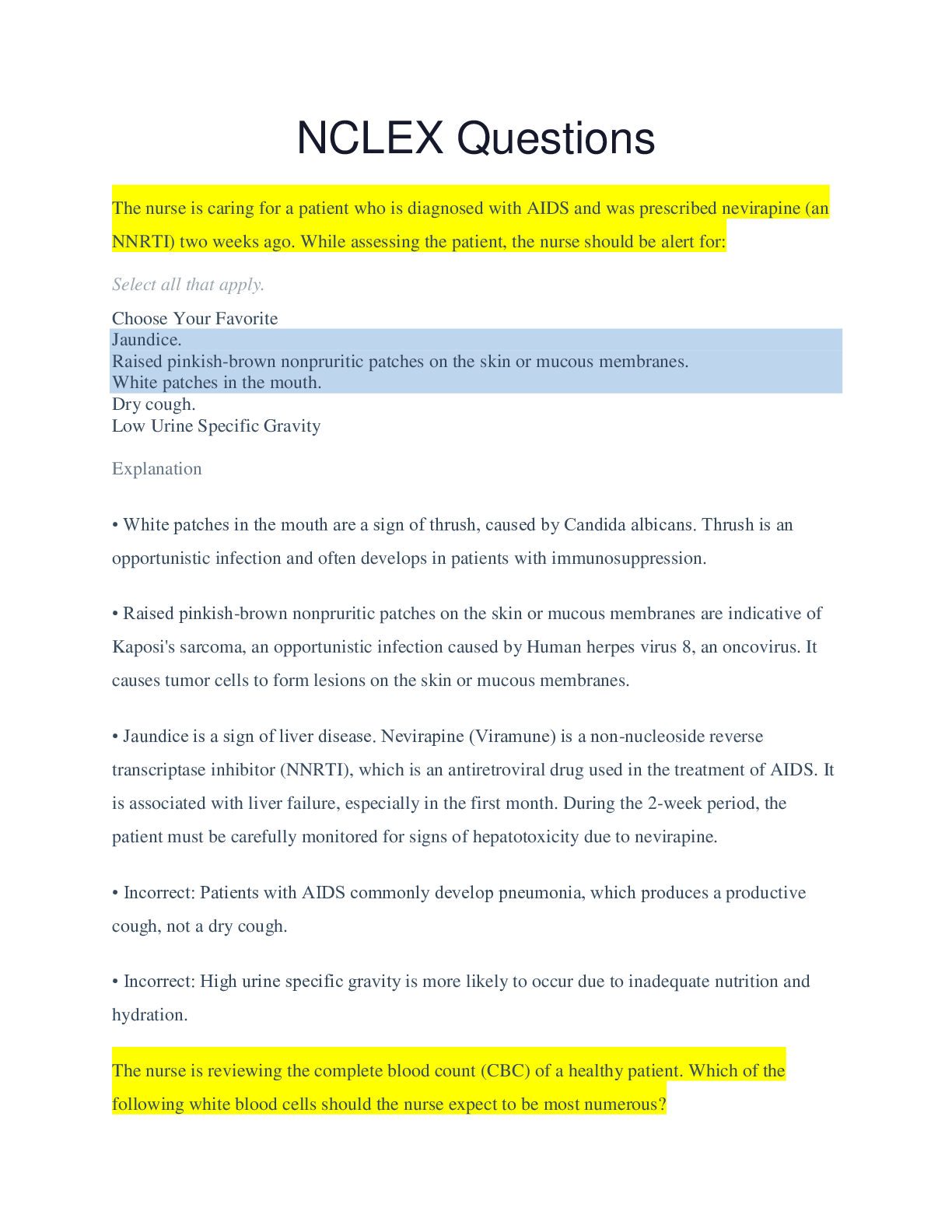
Buy this document to get the full access instantly
Instant Download Access after purchase
Buy NowInstant download
We Accept:

Reviews( 0 )
$10.00
Can't find what you want? Try our AI powered Search
Document information
Connected school, study & course
About the document
Uploaded On
Apr 11, 2020
Number of pages
22
Written in
Additional information
This document has been written for:
Uploaded
Apr 11, 2020
Downloads
0
Views
87

